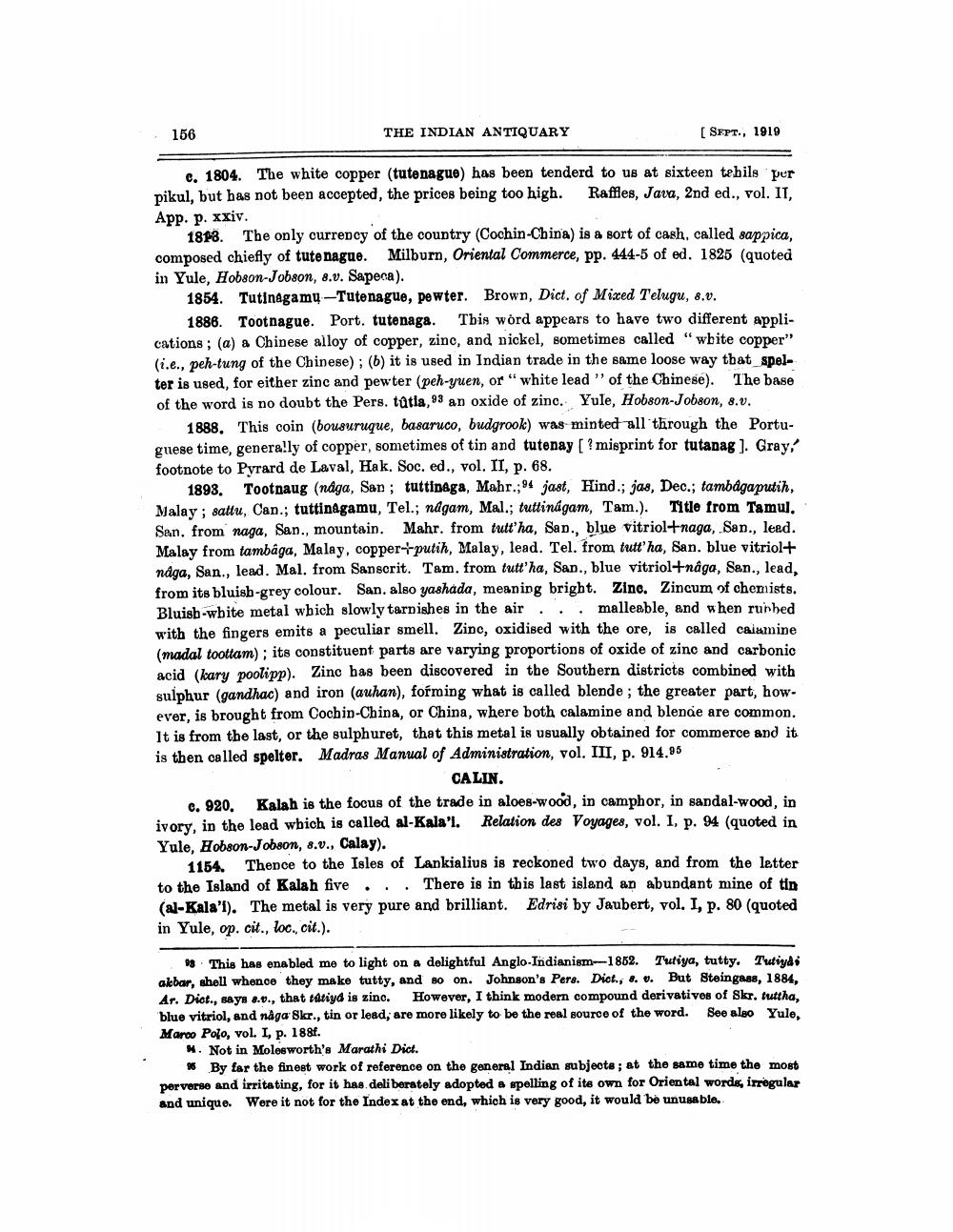________________
156
THE INDIAN ANTIQUARY
(SEPT., 1919
c. 1804. The white copper (tutonague) has been tenderd to us at sixteen tehils per pikul, but has not been accepted, the prices being too high. Raffles, Java, 2nd ed., vol. II, App. p. xxiv.
1818. The only currency of the country (Cochin-China) is a sort of cash, called sappica, composed chiefly of tute nague. Milburn, Oriental Commerce, pp. 444-5 of ed. 1825 (quoted in Yule, Hobson-Jobson, 8.v. Sapeca).
1854. Tutinagamų - Tutenague, pewter. Brown, Dict. of Mixed Telugu, 8.v.
1886. Tootnague. Port. tutenaga. This word appears to have two different applications; (a) a Chinese alloy of copper, zinc, and nickel, sometimes called "white copper" (i.e., peh-tung of the Chinese) ; (b) it is used in Indian trade in the same loose way that spelter is used, for either zinc and pewter (peh-yuen, or "white lead" of the Chinese). The base of the word is no doubt the Pers. tatia, 98 an oxide of zinc. Yule, Hobson-Jobson, 8.0.
1888. This coin (bousuruque, basaruco, budgrook) was minted all through the Portuguese time, generally of copper, sometimes of tin and tutenay [? misprint for tutanag ). Gray, footnote to Pyrard de Laval, Hak. Soc. ed., vol. II, p. 68.
1893. Tootpaug (någa, San; tuttinaga, Mahr.; 94 jast, Hind.; jas, Dec.; tambågaputih, Malay : sattu. Can.; tuttinagamu, Tel.; nagam, Mal.; tuttinagam, Tam.). Title from Tamul. San. from naga, San., mountain. Mahr. from tutt'ha, San., blue vitriol+naga, .San.. lead. Malay from tambaga, Malay, copper-putih, Malay, lead. Tel. from tutt'ha, San. blue vitriol+ någa, San., lead. Mal, from Sanscrit. Tam. from tutt'ha, San., blue vitriol+naga, San., lead. from its bluish-grey colour. San. also yashada, meaning bright. Zino. Zincum of chemists. Bluisb-white metal wbich slowly tarnishes in the air... malleable, and when run bed with the fingers emits a peculiar smell. Zinc, oxidised with the ore, is called calumine (madal toottam): its constituent parts are varying proportions of oxide of zinc and carbonic acid (kary poolipp). Zinc has been discovered in the Southern districts combined with sulphur (gandhac) and iron (auhan), forming what is called blende; the greater part, however, is brought from Cochin-China, or China, where both calamine and blende are common. It is from the last, or the sulphuret, that this metal is usually obtained for commerce and it is then called spelter. Madras Manual of Administration, vol. III, p. 914.95
CALIN. 6. 920. Kalah is the focus of the trade in aloes-wood, in camphor, in sandal-wood, in ivory, in the lead wbich is called al-Kala'l. Relation des Voyages, vol. I, p. 94 (quoted in Yule, Hobson-Jobson, 8.v., Calay).
1154. Thence to the Isles of Lankialius is reckoned two days, and from the letter to the Island of Kalah five ... There is in this last island an abundant mine of tin (al-Kala'l). The metal is very pure and brilliant. Edrisi by Jaubert, vol. I, p. 80 (quoted in Yule, op. cit., loc. cit.).
* This has enabled me to light on a delightful Anglo-Indianism--1862. Tutiya, tutty. Tutiydi akbar, shell whence they make tutty, and so on. Johnson's Pers. Dict., 8. 6. But Steingass, 1884, Ar. Dict., says 8.0., that taniyd is zinc. However, I think modern compound derivatives of Skr, tuttha, blue vitriol, and någa Skr., tin or lead, are more likely to be the real sourco of the word. See algo Yule, Marco Polo, vol. I, p. 188f.
M. Not in Molesworth's Marathi Dict.
* By far the finest work of reference on the general Indian subjecte ; at the same time the most perverse and irritating, for it has deliberately adopted a spelling of its own for Oriental worde, irregular and unique. Were it not for the Index at the end, which is very good, it would be unusable.




